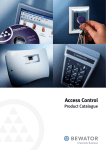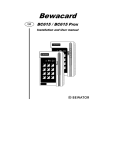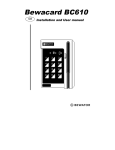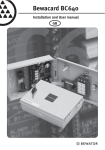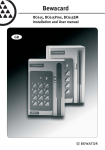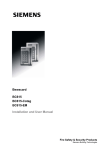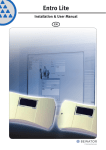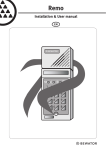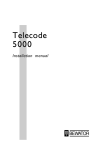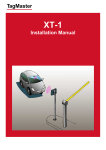Download Bewator BC610 Technical information
Transcript
Bewacard GB BC610 / BC610 Prox BC610EM Technical manual Copyright © 2003 Bewator AB, Solna, Sweden. Material from the BC610 Technical manual may only be copied with the consent in writing of Bewator. Bewator reserves the right to alter both the content of the manual and the design of the product. Document no: 80998-4 Bewator AB are part of the Swedish Bewator Group AB, which develops and markets a complete security product range that includes access control and alarm. Sales, installation and servicing are handled by a national dealer network. Actions (such as unauthorised manipulation, copying etc.), must not be taken with the software contained in the products and systems. Such actions are regarded as copyright violation and may result in imprisonment or fines and may likewise lead to an obligation to pay damages and compensation for using the software. Innehållsförteckning sida 3 (avsnitt 3 Udda) 3 Contents THIS IS THE BC610........................................................................... 4 How does the card reader work? ............................................ 4 Timing security levels .............................................................. 4 Examples of timing security levels, ........................................ 5 Duress ........................................................................................ 5 INSTALLING THE CARD READER .................................................. 6 HOW TO SELECT CONNECTING CABLES..................................... 7 INSTALLATION ................................................................................. 8 Installation continued............................................................... 9 PROXIMITY FUNCTION .................................................................. 10 General..................................................................................... 10 Reading distance .................................................................... 10 LAYOUT OF THE KEYPAD............................................................. 11 PROGRAMMING.............................................................................. 12 Buzzer and LEDs..................................................................... 12 Set password........................................................................... 13 Set the card reader to programming mode .......................... 13 Log on a card (with a card) .................................................... 14 Log on a card (without the card) ........................................... 14 Log on a series of cards......................................................... 15 Cancel card (with card) .......................................................... 15 Cancel card (without card)..................................................... 16 Program/change/erase the common code ........................... 16 Change the Door Opening time ............................................. 17 Buzzer on/off ........................................................................... 17 Erase the memory and reset the default settings................ 18 Change password ................................................................... 19 Card reading parameters ....................................................... 20 Door operation on change of toggle enable ........................ 21 PROGRAMMING OVERVIEW ......................................................... 22 NAME CHART.................................................................................. 23 DAILY USE....................................................................................... 24 Entrance................................................................................... 24 Choose/change PIN code....................................................... 25 Duress ...................................................................................... 25 TROUBLESHOOTING ..................................................................... 26 TECHNICAL INFORMATION .......................................................... 27 4 Bewacard 610 Technical Manual This is the BC610 BC610 is a compact card reader for magnetic cards – and BC610-Prox is a compact card reader for proximity cards. Both models have capacity for 500 cards. In the following chapters the name BC610 will refer to both models because the only difference is the way of reading cards. See also chapter Proximity function on page 10 for more information of the proximity function. How does the card reader work? BC610 can be used in different ways depending on the security requirements. If no external equipment (time clocks, push buttons etc.) is connected, card and common code can be used 24 hours a day. If no common code is programmed the card reader will only accept cards. Timing security levels Using external time clocks, a number of security levels can be set up. The security level determines what action is required to open the door. The following security levels exist: • Unlocked door. • Common code. A four-digit code (common to all users) is required to open the door. The common code is programmed by the person responsible for the card reader. • Card. The visitor must swipe his card to open the door. • Card + PIN. The visitor must swipe his card and enter a personal code to open the door. The cardholders can choose/change his or her personal code on the keypad. • Toggle function. Used together with current security level, i.e. Card, Common code or Card + PIN. When the card/code is swiped/entered the first time the door is opened and remains unlocked until the card/code is swiped/entered the next time. • Card reader disconnected. The card reader is completely disconnected. Only exit request works. Bewacard 610 Technical Manual 5 Examples of timing security levels, During office hours, when there are people in the premises, the security level may not need to be so high: Unlocked door or Common code are probably suitable levels. During lunchtime, the level may be raised to Card. The remaining time, i.e. evenings, nights and weekends Card + PIN is a suitable security level. The Toggle function can be used in premises where a person is responsible during certain hours, e.g. a class-room or a loading bay door. In a classroom, the teacher can open the door, which remains open until he or she locks the door. The pupils may come in and out without having cards or common code. Duress BC610 is equipped with a duress output. If a visitor is forced to open the door under threat, he or she may enter a special code that activates an alarm. Note! Duress is only applicable during the Card + PIN security level. 6 Bewacard 610 Technical Manual Installing the card reader Install the card reader at a height of 120–140 cm (from the floor to the bottom edge of the card reader). To cater for disabled persons, a suitable height is approximately 95 cm. When installing the BC610-Prox, care should be taken to avoid sources of electrical noise, such as motors, generators, pumps, computer installation and mains cabling. To install the card reader: 1 Open the card reader with the key supplied. The lock is located on the underside of the reader. 2 Fasten the back plate against the wall, using three screws according to the illustration below. Seal the screw and cable holes with sealant if the unit is externally mounted. 3 Make sure the back plate is earthed. Use a separate cable to the earthing point. Make sure the front and back plate is connected with the internal strap. 4 Fit the front and check that the card reader is securely fastened. Bewacard 610 Technical Manual 7 How to select connecting cables It is important to use cables with the correct conductor gauge, to keep the voltage drop in the cables as low as possible. • 12 volt supplies. A 12 V electric locking device generally needs at least 11 V to work properly, so the voltage at the card reader should never be less than 11 V. • 24 volt supplies. A 24 V electric locking device generally needs at least 21 V to work properly, so the voltage at the card reader should never be less than 21 V. The recommended gauge (cross-sectional area) of the conductor depends on the distance between the power supply and the card reader, and on the load at the card reader. The table below is for a Bewacard 610 with an electric release. The total load is 300 mA at 24 V or 600 mA at 12 V. Cable length (metres) 24 V Supply Min conductor dia area (mm) (mm2) 12 V Supply Min conductor area dia (mm2) (mm) 0-50 0.17 0.46 0.51 0.80 51-100 0.34 0.65 1.02 1.14 101-150 0.51 0.80 1.53 1.40 151-200 0.68 0.93 2.04 1.61 201-250 0.85 1.04 2.55 1.80 251-300 1.02 1.14 3.06 1.95 8 Bewacard 610 Technical Manual Installation 5 3 4 7 6 8 1 BACK LIGHT 9 2 SW1 10 + 8 9 10 11 12 13 TAMPER 15 14 11 0V TOGGLE PIN CODE 0V DURESS READER INHIBIT EXIT BUTTON LOCK 6 7 TAMPER 1 2 3 4 5 12-30V Bewacard 610 Technical Manual 9 Installation continued The numbers below refer to the numbers on the wiring diagram. 1 Electric locking device. Dashed line shows connection to locks with fail unlocked operation. 2 Power in, terminal block nos. 1 and 2. 3 Exit Request button. To operate short terminal nos. 6 and 9. Optionally, a time-clock can be connected to control a door that should be permanently open. 4 Input for reader inhibit. To operate short terminal nos. 7 and 9. The red LED on the fascia will be lit. 5 Duress output. Used for activating an external alarm. Use an E7 relay. Connect between terminal nos. 8 and + (1). 6 Remove the jumper if back lighting is not required. 7 Control input for Common code. Terminal nos. 10 and 13 open: Common code enabled. Terminal nos. 10 and 13 linked: Common code disabled. 8 Control input of Card and Card + PIN security levels. Terminal nos. 11 and 13 open: Card. Terminal nos. 11 and 13 linked: Card + PIN. 9 Control input for Toggle function. Link terminal nos. 12 and 13 to activate the toggle function. 10 The SW1 push button. Used to erase the memory and to set a new password. 11 Tamper switch. Normally closed when the housing is closed. 10 Bewacard 610 Technical Manual Proximity function General The Proximity function means that the reader can read cards or tags without them being in contact with the reader. The reader continuously transmits a low power radio frequency. When a card or tag is presented within the field of the reader it activates and transmits a unique identification number (card number) back to the reader. The reader can be mounted on all types of materials. The only limit is that the reader may not be completely surrounded by metal. Reading distance Depending on the type of cards or tags the reading distance could be slightly different. Active cards have a built-in battery, which gives a distance of approx. 10 centimetres. Passive cards lack the battery and give approx. 3 centimetres. Laminated cards (complete with magnetic stripe) are of passive type. Bewacard 610 Technical Manual 11 Layout of the keypad Diagram of the LEDs and push-buttons on the BC610 keypad. Yellow LED. Red LED. Indicates keypresses. Lit when PIN code should be entered. Indicates errors. E.g. cancellation of card following 3 incorrect PIN codes. Green LED. A. Initiates programming sequence, e.g A01 to log on cards. Also used when choosing PIN code (see page 25). 1 2 3 4 5 6 7 8 9 A 0 B Lit when the door is unlocked. E.g. Accepted card transaction B. Press B + the 6-digit password whenever you want to program BC610. Press B to leave programming mode. All LEDs are flashing in programming mode. The LEDs also have other indications explained in full later. 12 Bewacard 610 Technical Manual Programming In the sections below are the instructions on how to program BC610. To be able to program the card reader you have to set the card reader to programming mode. This is done by entering a six-digit code (see the next page). Buzzer and LEDs During programming you will be guided by the buzzer and the LEDs. In this manual the LEDs are illustrated in the following way: = Off z = Lit = Flashes In programming mode before a function is chosen: All three LEDs are flashing. During programming: The LEDs are lit or off depending on the function being programmed. Correct programming: Confirmed by a rising signal consisting of two quick beeps. Faulty programming: Confirmed by a falling signal consisting of one long and one short beep. Note! If, having entered programming mode, no key is pressed within 20 seconds, the unit will leave programming mode. Bewacard 610 Technical Manual 13 Set password The first thing to do before starting to programme the card reader is to set a password. 1 Open the card reader with the key supplied. The lock is located on the underside of the card reader. 2 Press the SW1 button (see wiring diagram on page 8). 3 Enter the desired 6-digit password on the card reader’s keypad. The password is now set. Set the card reader to programming mode To program a function, the card reader has to be in programming mode. Proceed as follows: 1 Press B. 2 Enter the 6-digit password. The card reader is now in programming mode. Note! If the wrong password is entered two times in succession, the card reader is blocked from further attempts for 10 seconds. From then on the card reader is blocked for 40 seconds each time two incorrect passwords are entered. 14 Bewacard 610 Technical Manual Log on a card (with a card) Using this function, the cards to be used are programmed in to the card reader. 1 Set the card reader to programming mode. 2 Press A01. 3 Swipe the card. If the card is already in the reader, the ”faulty programming” signal is heard. 4 Swipe the next card, as required. 5 When finished, press B to go back to programming mode. 6 Press B one more time to leave programming mode. zz Log on a card (without the card) Using this function cards can be programmed by keying in the card number. 1 Set the card reader to programming mode. 2 Press A03. 3 Enter the card number on the keypad. If the card is already logged on, the ”faulty programming” signal is heard. 4 Key in the next card, as required. 5 When finished, press B to go back to programming mode. 6 Press B one more time to leave programming mode. zz Bewacard 610 Technical Manual 15 Log on a series of cards Using this function you can quickly log on a contiguous series of cards. 1 Set the card reader to programming mode. 2 Press A04. 3 Enter the card number of the first card in the series. 4 Enter the card number of the last card in the series. The red LED flashes as the cards are logged on. 5 Press B to leave programming mode. zz Cancel card (with card) Using this function a card can be cancelled (with the card) so that it cannot be used in the card reader. 1 Set the card reader to programming mode. 2 Press A14. 3 Swipe the card. 4 Swipe the next card, as required. 5 When finished, press B to go back to programming mode. 6 Press B one more time to leave programming mode. z 16 Bewacard 610 Technical Manual Cancel card (without card) Using this function, cards can be cancelled using the card number. 1 Set the card reader to programming mode. 2 Press A16. 3 Enter the card number. If the card is not logged on the ”faulty programming” signal is heard 4 Cancel the next card, as required. 5 When finished, press B to go back to programming mode. 6 Press B one more time to leave programming mode. z Program/change/erase the common code This is how to program/change/erase a common code. 1 Set the card reader to programming mode. 2 Press A21. 3 Enter a four-digit common code. The existing code will be overwritten. zz Note! To erase the common code so that it does not work, enter 0000. 4 Press B to leave programming mode. Bewacard 610 Technical Manual 17 Change the Door Opening time The opening time determines for how long the lock should remain open following a correct entrance. The default is 7 seconds. This is how to change the opening time, if required. 1 Set the card reader to programming mode. 2 Press A28. 3 Enter the desired opening time (between 01 and 99 seconds). 4 Press B to leave programming mode. zzz Buzzer on/off The default is that the buzzer is activated. If you do not want the buzzer to beep on key presses or door opening, it can be turned off. Note that even when the buzzer is off for normal operation, it will continue to sound during programming. 1 Set the card reader to programming mode. 2 Press A65. 3 Press 0. 4 Press B to leave programming mode. zz To reactivate the buzzer, press 1 in step 3 instead. 18 Bewacard 610 Technical Manual Erase the memory and reset the default settings When the card reader’s memory is erased, the default settings are restored (see below). 1 Set the card reader to programming mode. 2 Open the card reader with the key supplied. The lock is located on the underside of the card reader. 3 Press the SW1 button (see the wiring diagram on page 8). 4 Press 112186. 5 Press 112186 one more time. All previously logged on cards have now been erased. The card reader reverts to the following settings: • Password: 112233 • Common code: None • Opening time: 7 seconds • Toggle security level: 0 • Card parameters: Position 9-16, the last 8 positions if fewer than 16 positions. Bewacard 610 Technical Manual 19 Change password To change the password: 1 Press B and enter the present password. 2 Press A27. 3 Enter the new password. A warning tone is heard. 4 Enter the new password again. The warning tone sounds until all six digits have been entered. 5 Press B to leave programming mode. 6 Make a note of the new password. zzz Note! If you should forget the password can you set a new password. Read the Set password section on page 13. 20 Bewacard 610 Technical Manual Card reading parameters Note! Card reading must not be changed if using a proximity card reader. Magnetic card reader When BC610 is delivered, the card reader reads positions 9 to 16 on the card’s magnetic strip, or the last 8 positions if they are fewer than 16. If you want to use your own cards and they should be read differently, enter from which position on the magnetic strip the reader should start reading and how many digits should be read (max. 8). Note! Previously logged on cards will not work if you change the card parameters. 1 Set the card reader to programming mode. 2 Press A97. 3 Enter from which digit in the card number (01-40) the digits should be read. zz To reset this function to the default setting, press A at this point. 4 Enter the number of digits to be read (1-8). 5 Press B to leave programming mode. Note! If less than 8 digits are used in the card number, add as many 0 digits as necessary to make up an eight-digit card number when using the A03, A04 and A16 commands. Example: If the card number is 5432, enter 00005432 when using the A03, A04 and A16 commands. Proximity reader When using proximity readers the co-operation between the reader and the cards are stated at the factory and cannot be changed. The digits used for logging on a card – or cancelling a card – will be the eight digits seen on the card. E g 00226225. Note! Only cards and tags delivered from Bewator will be valid because the identification number sent from the card contains more information than the eight digits visible on the card. Bewacard 610 Technical Manual 21 Door operation on change of toggle enable The default setting is that if the door is unlocked when a security level changes, the door will be locked immediately. This is setting 0 of this function. This function can be changed so that the door remains unlocked when a security level changes. This is setting 1 of the function. To lock the door a valid transaction must be performed as required during the new security level. (e.g. Card + PIN) 1 Set the card reader to programming mode. 2 Press A96. 3 Press 1 for setting 1. 4 Press 0 for setting 0 (this is the default setting). 5 Press B to leave programming mode. zz 22 Bewacard 610 Technical Manual Programming overview Step 1 Step 2 Step 3 Change Password Function Set card reader to programming mode Press A27 Enter a new password Enter the password again Step 4 Step 5 Log on cards(with the card) Set card reader to programming mode Press A01 Swipe the card Swipe the next card, as required Press B to revert to programming mode Log on cards (without the card) Set card reader to programming mode Press A03 Enter the card number Enter the next card number, as required Press B to revert to programming mode Log on a series of cards Set card reader to programming mode Press A04 Enter the first number in the series Enter the last number in the series Cancel cards (with card) Set card reader to programming mode Press A14 Swipe the card Swipe the next card, as required Press B to revert to programming mode Cancel cards (without card) Set card reader to programming mode Press A16 Enter the card number Enter the next card number, as required Press B to revert to programming mode Programme/c hange common code Set card reader to programming mode Press A21 Enter the common code (4 digits) Change door opening time Set card reader to programming mode Press A28 Enter the door open time (0199) Buzzer on/off Set card reader to programming mode Press A65 0 = Off Erase memory and set default settings Set card reader to programming mode Open the reader Press SW1 on the circuit board Enter 112186 Enter 112186 again Change card reading parameters Set card reader to programming mode Press A97 Enter the start position Enter the number of digits to be read Door operation on toggle function change Set card reader to programming mode Press A96 1 = On 0 = Door locks 1 = Door remains unlocked Bewacard 610 Technical Manual 23 Name chart Common Code: Name Card Number 24 Bewacard 610 Technical Manual Daily use Entrance To open the door the user should do the following: • Enter a four-digit common code (if Common code is the current security level). • Swipe a card (if Card is the current security level). • Swipe a card and enter a personal code belonging to the card (if Card + PIN is the current security level). Should the wrong PINcode be entered 3 times in succession the card is automatically cancelled and must be logged on once again. The toggle function If the toggle function is activated, the user can open the door in one of the above-mentioned ways (depending on the current security level). The door remains open until a user (need not be the same one as opened the door) again completes a valid transaction Note! A door that has been opened when the toggle function is activated will be locked automatically when the security level changes, if the toggle security function A96 is off. (Set to 0). Example: Between 08.00 and 16.59 the Common code security level applies. From 17.00 Card + PIN will be the current security level. A user unlocks the door using the common code at 16.45. The door will be locked automatically when the time clock changes the security level to Card + PIN at 17.00. The setting may be changed so that the door remains open even the security level changes. (See page 21). Bewacard 610 Technical Manual 25 Choose/change PIN code To choose/change your individual PIN: 1 Press A on the card reader’s keypad. 2 Swipe your card through the card reader. 3 If it is the first you are choosing a PIN code for this card, enter 0000. Otherwise enter the existing code. 4 Enter the new code using four digits. 5 Enter the new code again. You have now set the PIN for your card. Duress To activate the Duress alarm output if forced to open the door under threat (this works during the Card + PIN security level only): 1 Swipe the card through the card reader and enter the usual PIN code, only add 1 to the last digit in the code. Example 1: If the PIN code is 1234, press 1235 instead. Example 2: If the PIN code is 1239, press 1230 instead. When a duress code is entered, the door is opened at the same time as the alarm output is activated (an alarm is sent to a security guard or similar). The alarm output will be activated until it is reset by entering programming mode. 26 Bewacard 610 Technical Manual Troubleshooting Problem Possible cause Action Red, yellow and green LEDs blink on voltage feed. A button is pressed. Adjust the button. Memory error. Change card reader. Cannot enter Wrong password. programming mode. Red LED is lit after two trials. Choose a new password. Green LED is lit on accepted entrance but the door does not open. Check cable between card reader and lock. Change locks. Lock error. Attach jumper. The jumper between terminal block nos. 1 and 4 in the card reader is missing. A card is swiped The reader head is through the card reader loose. but nothing happens. No The reader head is beep is heard. dirty. The reader head is damaged. A card is swiped through the reader, a beep is heard, but nothing happens. Tighten the reader head. Clean the reader head using a special cleaning card. Change card reader or reader head. The card is not logged Log on the card. on. Card + PIN is the current security level and the card does not have a PIN code. Select a PIN code. Bewacard 610 Technical Manual 27 Technical information Power supply: 12-24 V AC/DC. Max power consumption: BC610: 60 mA. BC610Prox & BC610EM: 110 mA. Lock relay: Max 2A, 30 V DC. Duress output: Open collector to 0 volt. Max 500 mA, 30 V DC. Tamper switch: Max 1A, 30 V DC. Inputs: Normally pulled high. Active when they are pulled low, i.e. 0 V. Temperature range: BC610: –35° C to +50° C, at 90 % relative air humidity. BC610Prox & BC610EM: –30° C to +50° C, at 90 % relative air humidity. Housing protection class: IP54 Dimensions: 108 x 160 x 45 mm (WxHxD). BC610Prox is notified for use in following countries: Austria, Belgium, Denmark, Finland, France, Germany, Greece, Iceland, Ireland, Italy, Spain, Sweden, the Netherlands and United Kingdom. 28 Bewacard 610 Technical Manual Notes ____________________________________________________ ____________________________________________________ ____________________________________________________ ____________________________________________________ ____________________________________________________ ____________________________________________________ ____________________________________________________ ____________________________________________________ ____________________________________________________ ____________________________________________________ ____________________________________________________ ____________________________________________________ ____________________________________________________ ____________________________________________________ ____________________________________________________ ____________________________________________________ ____________________________________________________ ____________________________________________________ ____________________________________________________ ____________________________________________________ ____________________________________________________ ____________________________________________________ ____________________________________________________ ____________________________________________________ Bewacard 610 Technical Manual 29 ____________________________________________________ ____________________________________________________ ____________________________________________________ ____________________________________________________ ____________________________________________________ ____________________________________________________ ____________________________________________________ ____________________________________________________ ____________________________________________________ ____________________________________________________ ____________________________________________________ ____________________________________________________ ____________________________________________________ ____________________________________________________ ____________________________________________________ ____________________________________________________ ____________________________________________________ ____________________________________________________ ____________________________________________________ ____________________________________________________ ____________________________________________________ ____________________________________________________ ____________________________________________________ ____________________________________________________ ____________________________________________________ 30 Bewacard 610 Technical Manual ____________________________________________________ ____________________________________________________ ____________________________________________________ ____________________________________________________ ____________________________________________________ ____________________________________________________ ____________________________________________________ ____________________________________________________ ____________________________________________________ ____________________________________________________ ____________________________________________________ ____________________________________________________ ____________________________________________________ ____________________________________________________ ____________________________________________________ ____________________________________________________ ____________________________________________________ ____________________________________________________ ____________________________________________________ ____________________________________________________ ____________________________________________________ ____________________________________________________ ____________________________________________________ ____________________________________________________

































